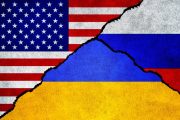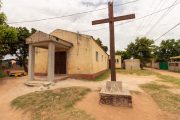
There are 7,000 beautiful stories people aren’t hearing, including his own, famous Cree playwright Tomson Highway said about Canada’s much-maligned Indian residential schools. “Nobody’s interested in the positive, the joy in that school [I attended],” he elaborated, talking to the now-defunct Huffington Post Canada in 2015. “Nine of the happiest years of my life I spent at that school. I learned your language…. Have you learned my language? No, so who’s the privileged one and who is underprivileged?”
Highway speaks for many Canadian Indians. Despite this, Pope Francis is now in Alberta apologizing for the very institutions the playwright was defending. The issue involves Francis because the schools, though created and funded by Canada’s government, were largely administered by the Catholic and Protestant churches.
The pope is issuing his mea culpa for missionaries’ “policies of forced assimilation and abuse” “that Indigenous children endured at mostly church-run residential schools,” to combine two matter-of-fact “hard news” statements made by ABC News and The Guardian, respectively, as the mainstream media harmonizes its message on this story. But how does this jibe with Highway’s testimonial or, for that matter, a now-deceased woman chief’s claim that many alleging abuse are lying for money? Are these unheard Indians masochists?
Or are the mainstream media sadistically mangling the Truth?
It’s doubtful that the pope, who’s issuing his apology today (Monday), will be meeting with Highway or the other like-minded Indians. In fact, a Sunday tweet (below) indicates that Francis accepts the politically correct narrative.
Also embracing this narrative (tweet below), though with juices-running-down-the-chin vigor, is unpopular Canadian Prime Minister Justin Trudeau.
Trudeau’s position is not surprising. After all, his father, famed ex-Prime Minister Pierre Trudeau, embraced the very policies Francis is apologizing for, the National Post informed last year. So focusing on alleged church abuses is convenient deflection.
The Truth Is Out There
So what’s the Truth? The New American addressed this in the 2021 essay “Churches Burn in Canada Based on Blood-libel Myth.” It’s rich in information, and I recommend you read it entirely, but here are some highlights:
- While media assert that all the residential school pupils had been forcibly seized from their families, many Indian parents wanted their children to attend. As Highway pointed out, we “came from so far north and there were no schools up there” — the residential institutions provided their only hope for an education. The aforementioned female chief, the late Cece Hodgson-McCauley, echoed this. “When her mother died, the future chief was six and her brother was two-and-half,” related LifeSite last year. “Her father was a trapper, and therefore had ‘no choice’ but to send his children to the Fort Providence residential school, administered by nuns, to be cared for during the school year.”
- This said, Indian children were for a time forcibly taken from their families — by the Canadian government (are you listening, Justin?). Author Michael O’Brien, a former residential-school pupil himself, mentioned this, pointing “to the chief underlying issue of the institutional abuse of children being removed from their families by the state authorities,” as LifeSite put it in a different 2021 article.
- Even so and in fairness, many good intentions underlay the government efforts. A good example is Canada’s first prime minister, John A. Macdonald, who largely jump-started the residential school system in 1883. A friend of the Indians who proposed legislation designed to give them the vote, he believed the schools and assimilation represented their only chance for modern-world success.
- Death rates were high during the residential schools’ early years — amounting to perhaps two to three percent of the approximately 150,000 students who attended the institutions — yet this largely reflects those times’ high child mortality overall. Note also that one high-death-rate period, 1910-’20, coincided with the Spanish Flu Epidemic of 1918-’19, which claimed many young people and which perhaps was even more deadly to Indian populations.
- Much has been made of residential schools having “mass unmarked graves,” with the implication that pupils were murdered wantonly. Reality: These are cemeteries whose existence has been known for years and which, at least in some cases, are merely abandoned community graveyards in which all kinds of people were buried.
Always Something to Apologize For
Of course, paraphrasing a famous quotation, “If you look for the worst in someone or something (apart from God), you’re sure to find it.” In any large system handling children there will be abuse (and we should zealously seek its eradication). A good example is how a 2004 federally funded study found that the child-sex-abuse problem in American government schools was 100 times the magnitude of the United States Catholic Church scandal — and is still ongoing. Yet, curiously, we hear little about this.
Yet also true is that when any large system offers massive payouts to victims, you’ll end up with not just victims but “victims.” Hodgson-McCauley mentioned this, insisting that many were fabricating abuse claims to cash in. For her part, she “described her years at the school as the best of her life,” LifeSite wrote.
“‘My family says the same thing, my sister swears by it,’ she told an interviewer,” the site later added.
“We were treated wonderfully.”
Despite this, and Pope Francis’ apology, Indian activists say they want “more.” “Many have called for financial compensation…,” The Guardian tells us. In other words, they may cry about assimilation, but they’re eager to further assimilate into the Canadian monetary system.
Of course, the Canadian government is offering $2 billion in compensation. Yet given that the activists complain about the loss of their traditional culture — which, as with that of whites’ ancient European ancestors, was doomed to pass away — why are we exacerbating the problem? The Indian activists should be paid in wampum.




